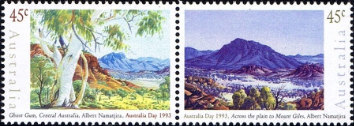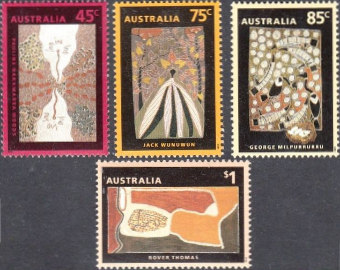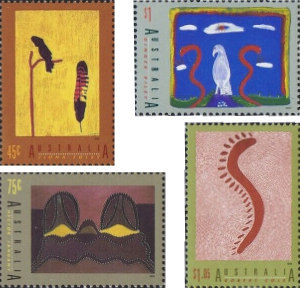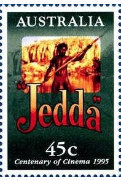History
Timeline results for
Found 1169 results for your search. Showing page 24 of 59.
1992
-
Labor Prime Minister Paul Keating’s Redfern speech at the launch of the International Year of the Indigenous People acknowledges past wrongs perpetrated against Aboriginal people.
1993
-
International Year of Indigenous People.
-
Due to growing public concern and pressure from Indigenous people the Aborigines Welfare Fund is frozen, ending deductions to the fund.
According to historians, Native Affairs Department budgets were frequently topped up with money from the fund and, during the Depression, the government took more than $5 million to cover consolidated revenue deficits [1].
By the time the welfare fund was frozen, all that remained was about $5 million. Up to 2008 it has accumulated another $5.8 million in interest [1].
-
To celebrate the International Year of Indigenous People, Australia Post issues two stamps for Australia Day that celebrate Aboriginal painter Albert Namatjira and his watercolour style. The stamps show a ghost gum and Mount Giles.

Albert Namatjira was famous for his use of water colours. -

The common theme of these paintings is 'Dreaming'. Australia Post issues a set of four stamps to celebrate the International Year of Indigenous People showing paintings by Aboriginal artists. They are: Wild Onion Dreaming by Pauline Nakamarra Woods (45c), Yam Plants by Jack Wunuwun (75c), Goose Egg Hunt by George Milpurrurru (85c) and Kalumpiwarra-Ngulalintji by Rover Thomas ($1).
-
The Wik Peoples make a claim for native title in the Federal Court of Australia for land on the Cape York Peninsula in Queensland. Native Title Act does not pass through parliament until December 1993.
-

This set showcases the work of four different Aboriginal artists. A second set of stamps celebrates the International Year of Indigenous People with the designs for this issue based on four Aboriginal artists' work: Black Cockatoo Feather by Fiona Foley (45c), Ngarrgooroon Country by Hector Jandany (75c), Ngak Ngak by Ginger Riley Munduwalawala ($1) and Untiled by Robert Cole ($1.05).
-

In a first for Vogue, Aboriginal model Elaine George of Brisbane becomes the cover girl for the September issue of Vogue Australia 1993, leading to a career as an international model. Elaine, a descendant from the Arakwal people of Byron Bay, was discovered as a 17-year-old at Dreamworld, a Gold Coast amusement park, by freelance photographer Grant Good. The issue became the highest selling Vogue in the then 34-year history of Australian Vogue.
-
Ayers Rock is renamed "Ayers Rock / Uluru", becoming the first official dual-named feature in the Northern Territory. The order of the dual names was officially reversed to "Uluru / Ayers Rock" on 6 November 2002 following a request from the Regional Tourism Association in Alice Springs.
-
In response to the landmark 1992 High Court Mabo decision the federal government passes the Native Title Act 1993 after one of the longest and most divisive parliamentary debates in Australia’s legislative history. This law recognises Aboriginal peoples' land based on the recognition by the common law and allows Indigenous people to make land claims under certain situations. They cannot make claims on freehold (i.e. privately-owned) land.
1994
-
Going Home Conference in Darwin. Over 600 people removed as children, from every state and territory, meet to share experiences and expose the history of the removal of Aboriginal children from their families and the effects of this policy on Aboriginal people. They discuss common goals of access to archives, compensation, rights to land and social justice.
-
Native Title Tribunal is established to hear land claims. Indigenous Land Fund is established as part of federal government’s response to the Mabo decision.
-
Native Title Act 1993 becomes law.
-
For the first time, Australia Day is celebrated nationally on the same day. Previously, states and territories had their own individual days.
-
The UN’s General Assembly marks this day as the International Day of the World’s Indigenous People.
1995
-
John Ah Kit (Australian Labor Party), from Darwin is elected to the Northern Territory Legislative Assembly representing the electorate of Arnhem.
-
Justice Drummond in the Federal Court makes a decision that the claim of the Wik and Thayorre Peoples could not succeed over the areas that were subject to pastoral leases. The judge’s reason was that he considered that the grant of pastoral leases under Queensland law extinguished any native title rights.
-
The National Inquiry into the Separation of Aboriginal and Torres Strait Islander Children from Their Families is established in response to efforts made by key Aboriginal agencies and communities. It examines the effects of separation, identify what should be done in response, find justification for any compensation and look at the laws of that time affecting child separation.
The inquiry holds hearings in all states between December 1995 and October 1996 and received 777 submissions, 69% of those from Indigenous people, 6% from churches and 1% from government.
-
The Australian Government proclaims the Aboriginal flag as an official ‘Flag of Australia’ under section 5 of the Flags Act 1953.
-

Jedda was the first Australian feature to employ Aboriginal lead actors. One stamp in the Centenary of Cinema issue features Jedda – the first Australian feature film to use Aboriginal actors in the lead roles and the first to be filmed in colour.




